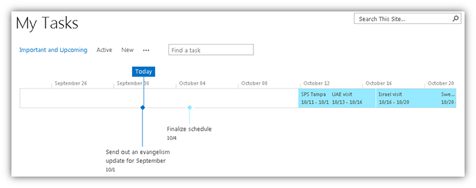Baby-Stepping Your Way into Project Management
After spending the first 15 or so years of my career largely in Project Management roles, I’m sort of a PM junkie when it comes to books and tools and methodologies of how to move something from ideation (PM wonk term for idea creation, or initiation phase) to delivery and, ultimately, support. When Arpan Shah moved from the SharePoint product team at Microsoft over to Project Server (he’s now working on Office365), I shared some advice with him (which I’m sure he doesn’t remember): don’t try to solve too many problems at once, but simplify the tool. As I got to know Christophe Fiessinger on Arpan’s team over the past couple years, I told him the same thing. So when I met with members of the revamped Project team a couple weeks back to talk about SharePoint 2013 and roadmap for SharePoint Online and Office365, I expected to have much the same conversation.
As they started to outline their strategy for SP2013, it quickly became apparent that they understood the need for simplicity as a way to improve participation in project management activities. For example, they talked about how people’s eyes generally glazed over when you refer to "projects" or "Gantt charts" or various project analytics. However, ask some whether they have "deadlines" and tasks, and they pay attention, they understand that language. As information workers, we all drive projects, we all — to some degree or another — keep task lists and try to juggle different deadlines. That simple view of project management was a key requirement, or theme, for the Project team going into SharePoint 2013. They wanted to be able to "baby-step" people into project management, giving formal Project Managers the tools they need, but also giving non-PMs easy-to-use capability, as well.
Anyone can create a task. From your personal view in SharePoint 2013, you can open a task list ands build a simple collection of activities and deadlines, viewing them by default as a list, or you can also organize them and assign more granular attributes, such as predecessors, percentage complete, assign additional owners, or capture other critical project management data. You can also change your view of these tasks to examine the work breakdown structure, look at the critical path via the Gant chart, see how the project flows across the calendar view, and create other customized views, as needed. SP2013 also provides a simple timeline view that is much easier to read than the Gantt, and can be configured to show only those tasks which pertain to you.
SP2013 provides powerful new features to aggregate or roll-up content from within a site, across a site collection, or across one or more farms. As part of this, end users can see all tasks assigned to them from across SharePoint — all from within their personal view. Plus, they can aggregate tasks from Outlook (as well as contacts and calendars), and link tasks to MS Project schedules, further automating task management — and giving PMs more tools to provide people with visibility (and accountability) into the project.
Two more features I’d like to mention: for portfolio management, you can also build into your view several project timelines, allowing you to see upcoming tasks, at a high level, from within a single view. This is a great utility for site collections or team sites where PMs may want to provide an aggregated or portfolio view to the team.
 And finally, as you begin to manage your tasks and deadlines in SharePoint, the platform helps productivity by surfacing important alerts and reminders each time you go to your homepage, acting more like the typical mobile experience. And what I mean is that SharePoint will provide you with reminders of upcoming tasks and any critical path (past due) items so that you can take action. No PM standing over you to crack the whip — the tool will remind you. (Of course, I can’t do anything about your PM still cracking the whip over you)
And finally, as you begin to manage your tasks and deadlines in SharePoint, the platform helps productivity by surfacing important alerts and reminders each time you go to your homepage, acting more like the typical mobile experience. And what I mean is that SharePoint will provide you with reminders of upcoming tasks and any critical path (past due) items so that you can take action. No PM standing over you to crack the whip — the tool will remind you. (Of course, I can’t do anything about your PM still cracking the whip over you)
I’m just beginning to explore additional scenarios so that I can understand the scale and limitations of what can be done with minimal configuration or customization. But out-of-the-box, SharePoint 2013 is proving to be a powerful project management solution for teams that will help you to further improve SharePoint adoption.







Great post! I’m looking forward to the project management features in 2013! There are great resources out there for those who want to use SharePoint for Project Management. See the free SharePoint Project Management template below. http://www.brightwork.com/community/free_sharepoint_project_management_template.asp?event=6